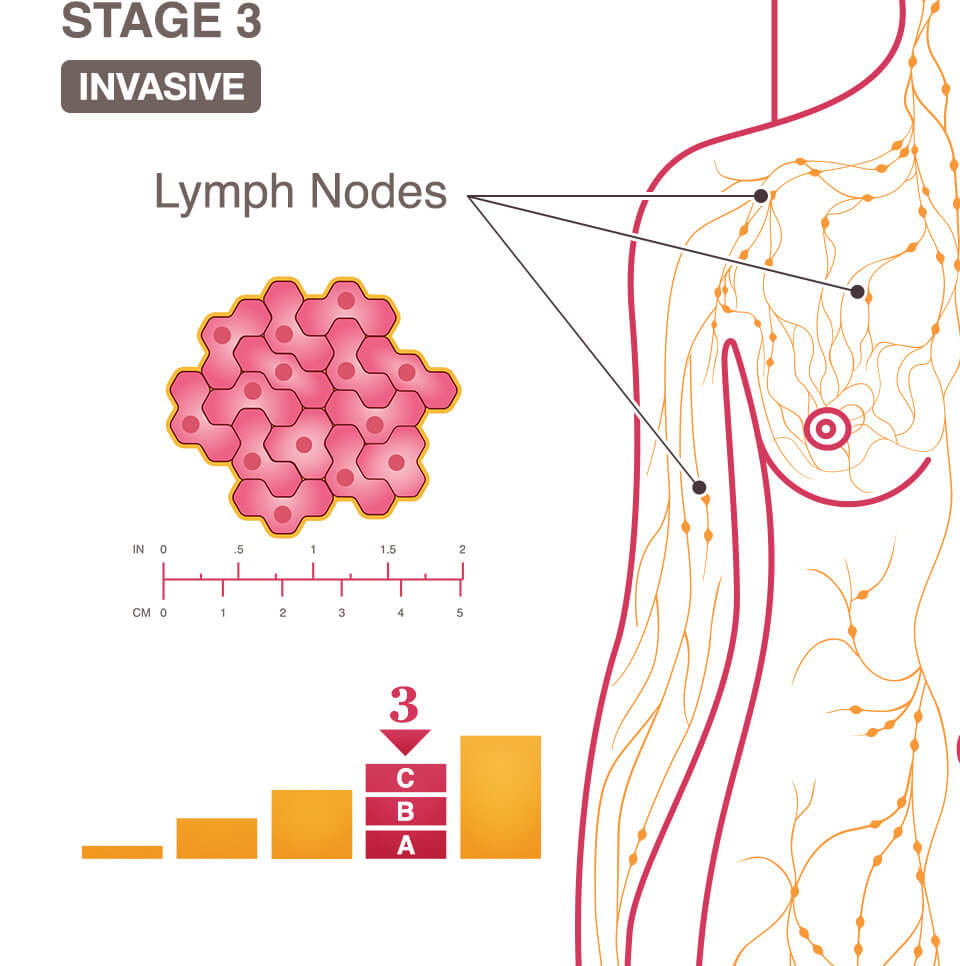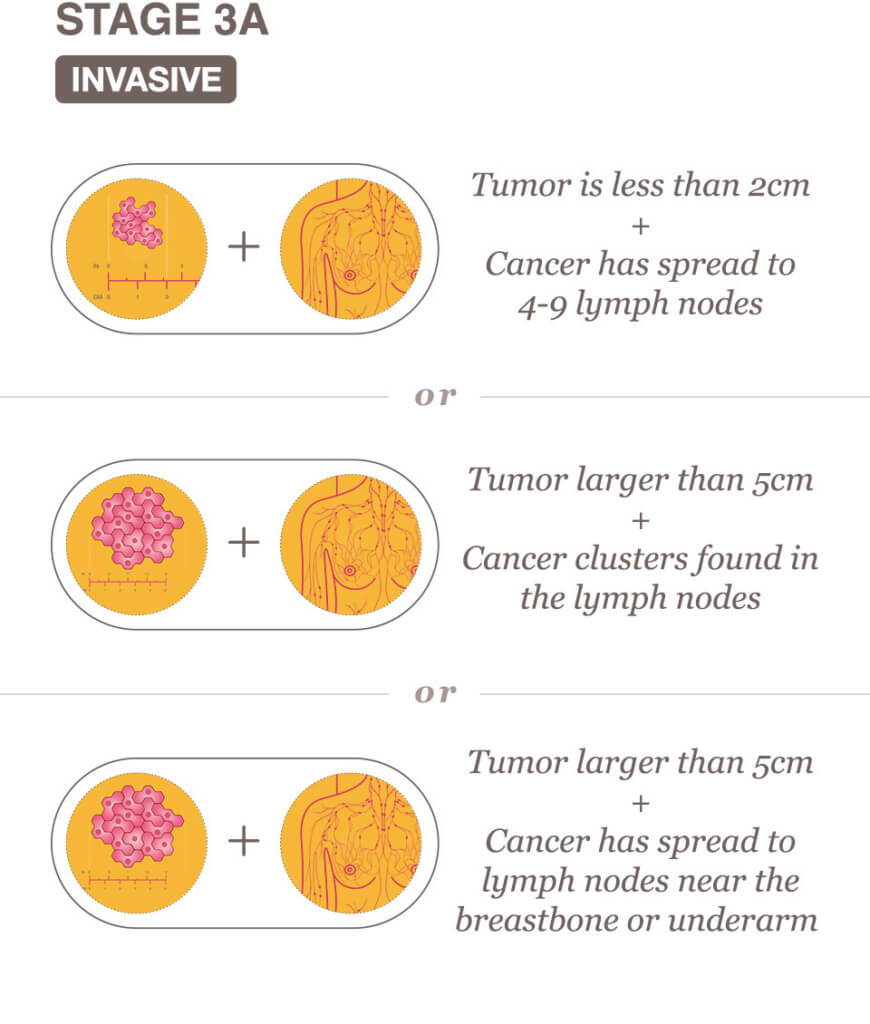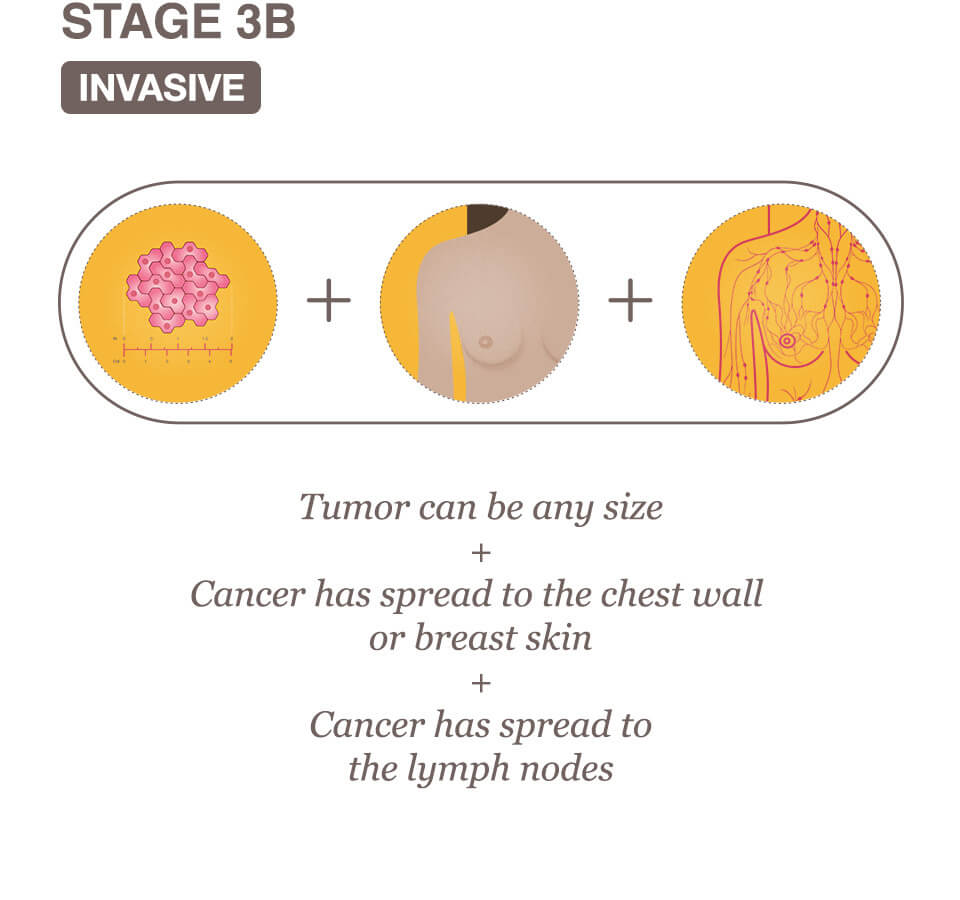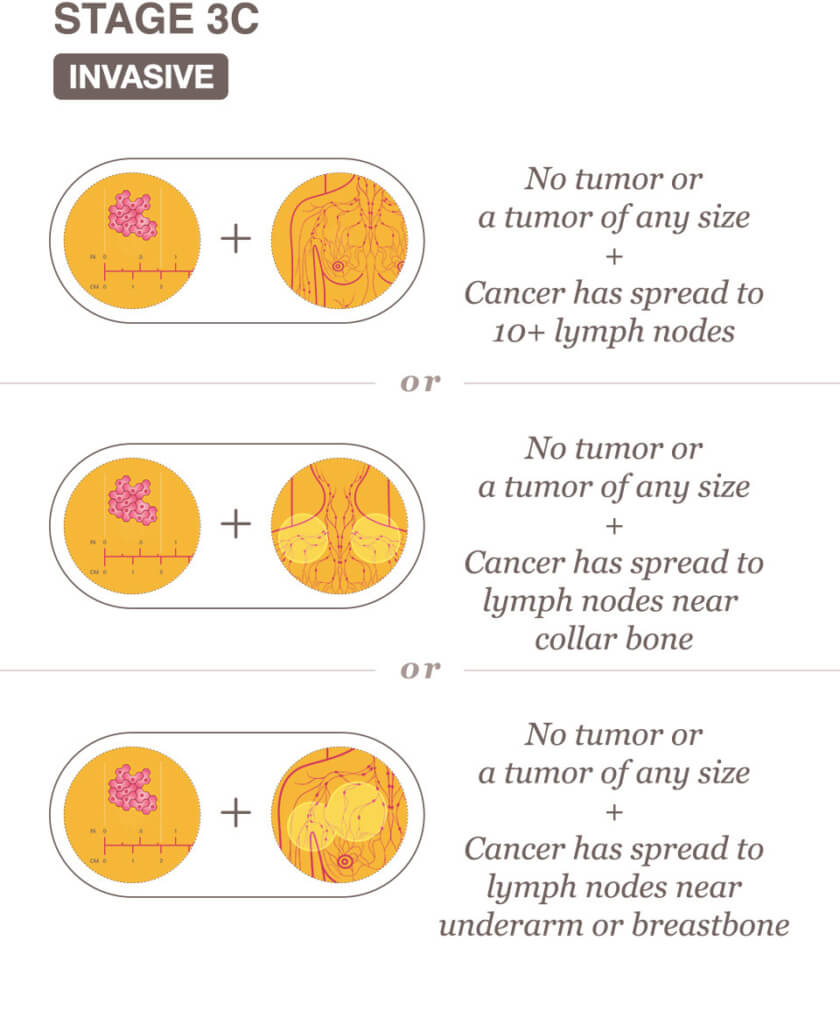Stage 3 Breast Cancer Overview
Stage 3 breast cancer is also called locally advanced breast cancer, meaning that the cancer is invasive and has spread out of the immediate, or local, area in the breast and into the lymph nodes or muscles close to the breast. The cancerous tumor in Stage 3 breast cancer, if present, is likely larger than tumors in Stage 1 or Stage 2 breast cancer.
Because Stage 3 breast cancer is considered advanced breast cancer, it may present some physical symptoms, such as a lump in the breast that can be felt, or changes to the breast shape, size, or skin texture. There may also be lumps felt in the underarm area. Read more about the signs and symptoms of breast cancer and always report any breast changes to your doctor.
All types of invasive breast cancers, such as invasive ductal carcinoma (IDC), invasive lobular carcinoma (ILC), triple negative breast cancer (TNBC), and inflammatory breast cancer (IBC), can be classified as Stage 3 if the cancer meets the requirements of having spread into nearby lymph nodes or muscles.
The 5-year survival rate for Stage 3 breast cancer is 87%, according to the American Cancer Society.
Table of contents
- What is Stage 3 breast cancer?
- Stage 3A breast cancer
- Stage 3B breast cancer
- Stage 3C breast cancer
- Stage 3 inoperable breast cancer
- Symptoms of Stage 3 breast cancer
- Stage 3 breast cancer treatment options
- Stage 3 breast cancer survival rates
- Stage 3 breast cancer prognosis
- FAQ
What does it mean to have Stage 3 breast cancer?

Stage 3 breast cancer means that the breast cancer has extended to, or spread, beyond the immediate region of the cancerous tumor and may have invaded nearby lymph nodes and muscles, but it has not spread to distant organs, such as the bones, liver, lungs, or brain. Although this stage is considered to be advanced, there are a growing number of effective treatment options for Stage 3 breast cancer.
Stage 3 breast cancer is divided into three groups: Stage 3A, Stage 3B, and Stage 3C. The difference is determined by the size of the tumor and whether the cancer has spread to the lymph nodes and surrounding tissue.
Stage 3A breast cancer
Stage 3A breast cancer is the lowest, or earliest, classification of Stage 3 breast cancer. In Stage 3A breast cancer, the invasive cancer has spread out of the breast tissue and into the nearby lymph nodes.
Stage 3A breast cancer means one of the following descriptions applies:
The cancerous cells or the tumor may be any size, AND the nearby lymph nodes (4 or more nodes with as many as 9 affected) contain cancer.
OR
The tumor is larger than the approximate size of a small lime (more than 5 centimeters), AND small clusters of breast cancer cells are found in the lymph nodes between the approximate size of a pinprick and the width of a grain of rice (about 0.2mm – 2.0mm).
OR
The tumor is larger than the approximate size of a small lime (more than 5 centimeters), AND the cancer has spread to 1, 2, or 3 lymph nodes under the arm or near the breastbone.

Stage 3B breast cancer
In Stage 3B breast cancer, the invasive cancer has spread beyond the breast tissue and lymph nodes and into the chest wall. The cancer may also have spread to the skin of the breast.
Stage 3B breast cancer means one of the following descriptions applies:

The tumor can be any size and has spread to the chest wall (the structures and tissues, such as muscles, fat, and bones, that protect the vital organs in and around the chest)
OR
There may be no actual tumor found in the breast but the skin of the breast is affected with evidence of swelling, inflammation, or ulcers (such as with cases of inflammatory breast cancer)
AND
The cancer may have spread to up to 9 nearby lymph nodes
OR
The cancer may have spread to the chest wall (the structures and tissues, such as muscles, fat, and bones, that protect the vital organs in and around the chest)
Stage 3C breast cancer
Stage 3C breast cancer is invasive cancer that has spread beyond the breast tissue and lymph nodes and into the chest wall. The cancer may also have spread to the skin of the breast. In Stage 3C breast cancer, the cancer has spread into more lymph nodes than in Stage 3B breast cancer.
Stage 3C breast cancer means one of the following descriptions applies:
The tumor can be any size and has spread to the chest wall (the structures and tissues, such as muscles, fat, and bones, that protect the vital organs in and around the chest)
OR
There may be no actual tumor found in the breast but the skin of the breast is affected with evidence of swelling, inflammation, or ulcers (such as with cases of inflammatory breast cancer)
AND
The cancer may have spread to 10 or more nearby lymph nodes
OR
The cancer has spread to lymph nodes above or below the collarbone
OR
The cancer has spread to lymph nodes near the underarm or breastbone

Stage 3 inoperable breast cancer
Stage 3C breast cancer is divided into categories: operable and inoperable. However, the term “inoperable” is not the same as “untreatable.”
If your physician uses the word “inoperable,” it may simply mean that surgery at this time would not be enough to remove all the breast cancer that is within the breast and the tissue around the breast. For those with inflammatory breast cancer, it is unusual to do surgery because of the degree of skin involvement.
There must be healthy tissue at all of the margins of the breast when it is removed. Keep in mind that the breast tissue goes beyond the breast mound – it goes up to the clavicle (collarbone) and down to a few inches below the breast mound. There must also be tissue to close the chest wound after the surgery is performed.
In Stage 3 inoperable breast cancer, a systemic treatment method, such as chemotherapy, may be used first to shrink the tumor as much as possible before surgery is undertaken.
Stage 3 breast cancer symptoms
Not all breast cancer causes symptoms that can be felt or observed. However, since Stage 3 breast cancer is a locally advanced cancer, signs and symptoms may begin to appear.
Signs and symptoms of Stage 3 breast cancer may include:
- A change in the skin texture or enlargement of the pores in the skin of the breast (some describe this as similar to the texture of an orange peel), including dimpling, redness, or scaliness
- Ulcerated skin on the breast (an open sore or a break in the skin)
- Breast pain, itchiness, or irritation
- A lump in the breast and/or armpit
- Changes to the size or shape of the breast, including swelling of the breast
- Changes in the nipple, such as peeling or flaking, or an inverted nipple
- Nipple discharge, which can be clear, cloudy, or bloody
All breast changes should be checked by your healthcare provider immediately. Read more about breast cancer signs and symptoms.
Stage 3 breast cancer treatment
Treatment options for Stage 3 breast cancer depend on several factors, including:
- The type of cancer cells of the original cancer
- The subtype of the original breast cancer: estrogen receptor positive (ER+), progesterone receptor positive (PR+), human epidermal growth factor receptor positive (HER2+), or triple negative breast cancer (TNBC)
- Whether or not the patient is postmenopausal
- Other health conditions the patient may have
Your oncologist will help you determine which course of treatment for Stage 3 breast cancer is best based on the factors above.
Stage 3 breast cancer treatment options vary widely and may consist of chemotherapy, surgery, radiation, targeted therapy, and hormonal therapy. Nearly every person with a Stage 3 breast cancer diagnosis will do best with a combination of two or more treatments.
Chemotherapy for Stage 3 breast cancer
In Stage 3 breast cancer, chemotherapy is most often given first with the goal to shrink the breast cancer within the breast and lymph nodes that are affected. Receiving chemotherapy before surgery is known as neoadjuvant chemotherapy.
Surgery for Stage 3 breast cancer
Surgical options to treat Stage 3 breast cancer usually include mastectomy, which is the surgical removal of breast tissue.
In some cases, Stage 3 breast cancer surgery options may include breast-conserving surgery, such as lumpectomy, partial mastectomy, or skin-sparing mastectomy. Your surgical oncologist will be able to help you determine which surgical option is best for you.
Questions about breast cancer surgery?
Download the free Breast Cancer Surgery eBook to learn about surgery types, reconstruction, and healing after surgery.
Breast Cancer Surgery: What You Need to KnowBiologic targeted therapy for Stage 3 breast cancer
Biological targeted therapy is sometimes used in conjunction with other therapies to treat Stage 3 breast cancer. Biologic targeted therapy attacks specific breast cancer cells without harming normal cells and often has less severe side effects than standard chemotherapy drugs.
Stage 3 breast cancer survival rate
Survival rates for breast cancer are based on a 5-year relative survival rate. This rate compares women with the same type and stage of breast cancer to women in the general population.
The 5-year relative survival rate for Stage 3 breast cancer is 87%, according to the American Cancer Society. This means that at the end of 5 years, 87% of women diagnosed with Stage 3 breast cancer will have survived.
The table below shows the survival rates for all levels of breast cancer, including Stage 3, which is considered regionally advanced breast cancer.
Breast cancer survival rates by SEER* stage
| SEER stage | 5-year relative survival rate |
| Localized: There is no sign that cancer has spread outside of the breast. Includes only invasive breast cancer, not DCIS. | 99% |
| Regional: The cancer has spread outside of the breast to nearby structures or lymph nodes. | 87% |
| Distant: The cancer has spread to different parts of the body, such as the bones, lungs, liver, or brain. | 32% |
| All SEER stages combined | 91% |
**Table information provided by the American Cancer Society
Stage 3 breast cancer prognosis
A prognosis is the likely outcome or course that a disease, such as breast cancer, will take, and includes the chance of recovery or recurrence. Since Stage 3 breast cancer is considered regionally advanced breast cancer, its prognosis is not as favorable as Stages 0, 1, or 2. When compared with earlier stages, women with Stage 3 breast cancer may face a lower 5-year relative survival rate (87%) and carry a higher risk for the breast cancer to recur or metastasize.
Stage 3 breast cancer FAQs
Is Stage 3 breast cancer curable?
While you are not likely to hear a doctor use the word “curable,” they may use the term “cancer free.”
Stage 3 breast cancer is treatable and has a 5-year relative survival rate of 87%. Many women with Stage 3 breast cancer will eventually be declared “cancer free” after successful treatment.
Is Stage 3 breast cancer terminal?
Stage 3 breast cancer is advanced cancer, but it is not terminal and has several options for treatment. Though stage 3 breast cancer carries a higher risk of distant recurrence in the future, treatments such as chemotherapy, biological targeted therapy, hormonal therapy, CDK4/6 inhibitor therapy, and other newer drug classifications are making an impact. These newer drugs are able to target specific proteins which contribute to cancer spreading to other organs. With these advances, it is anticipated that over time, we will see higher survival rates for all stages of breast cancer.
Can you live 20 years with Stage 3 breast cancer?
There are many women diagnosed and treated for Stage 3 breast cancer living more than 20 years. Even some women with Stage 4 breast cancer, whose metastatic tumors are HR+, HER2-, are living 20 years or more.



